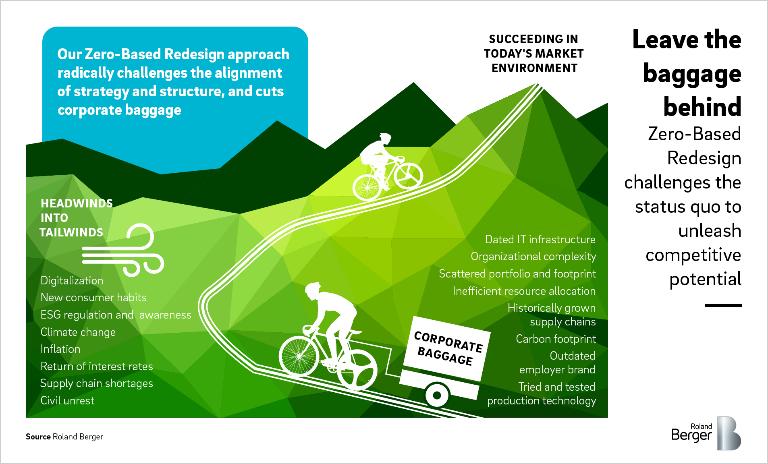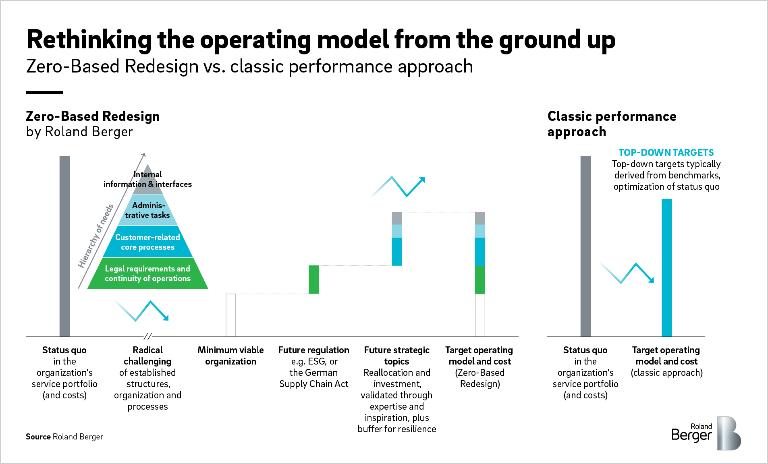Detox your business: Simplification is the ideal way for companies to equip themselves for a future shaped by volatile and complex markets.


Turning headwinds into tailwinds with Zero-Based Redesign
Our approach to exploit volatility and sustainably transform your organization
With businesses facing unprecedented challenges and uncertainty, adaptation is becoming the key to survival. Zero-Based Redesign offers a unique transformation proposition, focused on a complete redesign of the operating model around future customer needs, market dynamics, regulation and resilience. It’s a complex undertaking, but Roland Berger has the tools to guide you through it and ensure you turn the current headwinds into tailwinds.

These are volatile times for businesses. From pandemic worries to rising prices, stricter regulations and supply shortages, the present and future are both challenging and uncertain. Companies need to adapt to survive.
But in the face of these unprecedented headwinds, they cannot simply rely on traditional recipes for success, such as expansion, new products or acquisitions. These only add to complexity and costs, and hinder decision-making. Instead, we believe companies must unshackle themselves from their corporate baggage and mobilize to turn headwinds into tailwinds. To achieve this, a new regimen is required – Zero-Based Redesign (ZBR).
What is ZBR and how can it help?
Transformation approaches differ in their extremity. At the lower end are attempts to maintain the status quo and classic performance improvement methods. These ask questions like “How can we do more with less?”, and “How can we be leaner?”. These help to cut costs and lower resource requirements but fail to address bigger picture issues such as market dynamics and company perception.
At the opposite, radical end of the transformation spectrum is the ultra-lean minimum viable organization. This focuses on bare necessities (value proposition, compliance) to minimize costs and improve agility. But the whittling down of resources can leave a company unable to monitor market dynamics or be proactive.
Zero-Based Redesign fits neatly between the two. It takes a pragmatic, future-oriented view on customer needs, market dynamics, regulatory requirements and resilience – and then redesigns the target operating model from the ground up. To do this, ZBR seeks to determine which parts of the existing operating model (activities, processes, organization etc.) justify their existence under the status quo, and what capabilities the organization needs to thrive in the new market dynamics. The process therefore goes beyond mere cost-cutting and instead ensures a more sustainable transformation and firm platform to enact culture change.
Another benefit is that ZBR suits a large variety of transformation situations. From entire companies to specific business functions (especially Finance, HR, Sales, R&D and Procurement) and individual processes, it can be applied at multiple organizational levels.
The Roland Berger approach to ZBR
We have developed a five-step ZBR approach to bring market orientation back to mature businesses. Each step relates to a different area of the operating model, posing several questions.
- Survival minimum with 'hierarchy of needs': What are our core capabilities from a market and customer perspective? Out of everything we do, what are the bare necessities from an operational continuity and compliance standpoint?
- Performance inventory & future portfolio: From a market perspective, which capabilities or services do we require in the future? Which industry best practices can inspire us?
- ZBR for processes and organization: With which processes do we deliver our future capability and service portfolio? How do we design our operating model and organization around these processes?
- Measure and migration concept: How do we transform the existing organization into our envisaged target operating model? What will our future governance look like? How can we reinvest our resources and upskill our people?
- Implementation: How do we effectively turn the Zero-Based Redesign concept into reality, track progress and manage deviations?
In addition to the five core steps, our approach includes further actions to stabilize an organization’s transformation and improve agility: change management and zero-based budgeting. In our experience, transformation is a people challenge, and involving employees in change management is critical. To ensure buy-in, active and candid communication is key. Zero-based budgeting, meanwhile, helps to set financial goals that secure the change.
A formula for success
Zero-Based Redesign projects can be complex. To manage this, we developed a toolbox of instruments to facilitate and enable a client’s journey.
For example, our inspiration workshops draw on a network of more than 1,000 experts from academia, industry and other fields. They can be lectures, Q&A discussions with internal or external thought leaders, or functional working groups.
In addition, we have had very good experience of agile sprints. We use this method to break down the ZBR concept (or individual processes) into digestible chunks ("user stories" or "epics"), quickly develop and test prototypes, and then put them into action. The method is optional, ideal for use in digital settings and perfect to show people the impact they can have.
We have used such tools to help numerous clients from a diverse range of industries to successfully conceptualize and implement Zero-Based Redesign projects. In the past three years alone, they have resulted in added value of more than EUR 5 billion. Our experience and proprietary tools, such as the RBboost app, are proven success drivers, and we have consistently been ranked #1 in the market for performance improvement and implementation consulting since 2014 (by brand eins). So why not get in touch to see what Roland Berger can do for you?
Register now to download the full publication on Zero-based Redesign with insights into the five steps framework towards a stabilized transformation process and get regular insights into restructuring and performance improvement topics.






